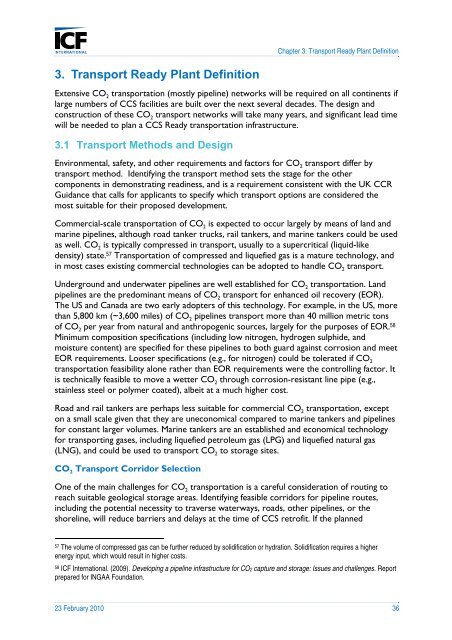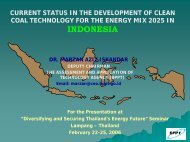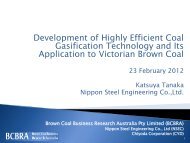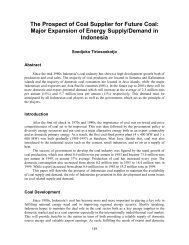Defining CCS Ready: An Approach to An International Definition
Defining CCS Ready: An Approach to An International Definition
Defining CCS Ready: An Approach to An International Definition
- No tags were found...
You also want an ePaper? Increase the reach of your titles
YUMPU automatically turns print PDFs into web optimized ePapers that Google loves.
Chapter 3: Transport <strong>Ready</strong> Plant <strong>Definition</strong>3. Transport <strong>Ready</strong> Plant <strong>Definition</strong>Extensive CO 2 transportation (mostly pipeline) networks will be required on all continents iflarge numbers of <strong>CCS</strong> facilities are built over the next several decades. The design andconstruction of these CO 2 transport networks will take many years, and significant lead timewill be needed <strong>to</strong> plan a <strong>CCS</strong> <strong>Ready</strong> transportation infrastructure.3.1 Transport Methods and DesignEnvironmental, safety, and other requirements and fac<strong>to</strong>rs for CO 2 transport differ bytransport method. Identifying the transport method sets the stage for the othercomponents in demonstrating readiness, and is a requirement consistent with the UK CCRGuidance that calls for applicants <strong>to</strong> specify which transport options are considered themost suitable for their proposed development.Commercial-scale transportation of CO 2 is expected <strong>to</strong> occur largely by means of land andmarine pipelines, although road tanker trucks, rail tankers, and marine tankers could be usedas well. CO 2 is typically compressed in transport, usually <strong>to</strong> a supercritical (liquid-likedensity) state. 57 Transportation of compressed and liquefied gas is a mature technology, andin most cases existing commercial technologies can be adopted <strong>to</strong> handle CO 2 transport.Underground and underwater pipelines are well established for CO 2 transportation. Landpipelines are the predominant means of CO 2 transport for enhanced oil recovery (EOR).The US and Canada are two early adopters of this technology. For example, in the US, morethan 5,800 km (~3,600 miles) of CO 2 pipelines transport more than 40 million metric <strong>to</strong>nsof CO 2 per year from natural and anthropogenic sources, largely for the purposes of EOR. 58Minimum composition specifications (including low nitrogen, hydrogen sulphide, andmoisture content) are specified for these pipelines <strong>to</strong> both guard against corrosion and meetEOR requirements. Looser specifications (e.g., for nitrogen) could be <strong>to</strong>lerated if CO 2transportation feasibility alone rather than EOR requirements were the controlling fac<strong>to</strong>r. Itis technically feasible <strong>to</strong> move a wetter CO 2 through corrosion-resistant line pipe (e.g.,stainless steel or polymer coated), albeit at a much higher cost.Road and rail tankers are perhaps less suitable for commercial CO 2 transportation, excep<strong>to</strong>n a small scale given that they are uneconomical compared <strong>to</strong> marine tankers and pipelinesfor constant larger volumes. Marine tankers are an established and economical technologyfor transporting gases, including liquefied petroleum gas (LPG) and liquefied natural gas(LNG), and could be used <strong>to</strong> transport CO 2 <strong>to</strong> s<strong>to</strong>rage sites.CO 2 Transport Corridor SelectionOne of the main challenges for CO 2 transportation is a careful consideration of routing <strong>to</strong>reach suitable geological s<strong>to</strong>rage areas. Identifying feasible corridors for pipeline routes,including the potential necessity <strong>to</strong> traverse waterways, roads, other pipelines, or theshoreline, will reduce barriers and delays at the time of <strong>CCS</strong> retrofit. If the planned57 The volume of compressed gas can be further reduced by solidification or hydration. Solidification requires a higherenergy input, which would result in higher costs.58 ICF <strong>International</strong>. (2009). Developing a pipeline infrastructure for CO2 capture and s<strong>to</strong>rage: Issues and challenges. Reportprepared for INGAA Foundation.23 February 2010 36
















